Posted by
Susan Sharma
on
February 22, 2007

Selling the Tiger to Save it?
"Enforcement of wildlife laws in China is lax, one of the main reasons that smuggling is so rampant and this laxity will extend to the tiger farms rendering any system of monitoring ineffetive. In the event of the lifting of the ban on trading in tiger parts,
laundering of wild animals through legal channels will thus be the more than likely outcome."
Dr. Xu Hongfa, China Director of TRAFFIC agreed with Indian wildlife experts that farmed tigers will always be more expensive than poached ones, doing little to dampen the profitability of poaching.
What the Chinese government really needs to be focussing on is habitat conservation, Dr.u says. He blames the dramatic depletion of China’s tigers on an equally dramatic loss of habitat for the animals as a result of deforestation and expansion of large-
scale agriculture. Until some of its natural environment is brought back, no amount of breeding will save the wild tiger, he concludes.
Source: The Hindu dated 21/02/07
|
Posted by
Susan Sharma
on
February 20, 2007

“In India, as in China, stimulating an interest in nature is a task of the utmost and immediate importance. With both economies growing at rates of around ten percent
a year, whole ecosystems risk being destroyed. In India the most recent example is the famed bird reserve of Bharatpur. The increased demand for water in Rajasthan has lead to the diversion of the water supply from Bharatpur, the winter home of 70,000 migatory
birds, or rather what was the winter home of 70,000. Since the local river was re-channeled the birds don’t come anymore….
In Britain surveys have found that 85% of respondents have stated that they learn most about their environment from television. Patently India is not necessarily
a direct parallel, however there is no doubt that television could have a positive role to play in creating awareness among India’s 1.1 billion people. A sizeable proportion of the population do not have access to television, but hundreds of millions do. It
is vital then that a strong and vibrant natural history industry evolves to supply this huge market with home grown films to reinforce the sense of wonder and respect for nature that needs to be there, so it can be defended…..
………….In my personal view creating air time on Indian channels is vital to generate a successful Indian wildlife film industry not merely as a platform to sell to
American channels but also help preserve India’s wildlife treasures…”
Jeremy Bristow, award winning environmental film producer
Source:
http://www.wildfilmnews.org/
|
Posted by
Susan Sharma
on
February 13, 2007

Nova NetTV
When one talks about E-governance for conservation, most of us dismiss the idea as one whose time has not come.
But an article I read at the following link called
the 100 dollar un-pc
http://jasonoverdorf.blogspot.com/
reassures me that the day is not far when we can achieve that.
The article talks about the revolutionary product Nova net tv which is a PC costing less than Rs 5000/-
Rajesh Jain, co-founder of Novatium
says that in India’s PC market there are 10 million relatively wealthy Indians at the "top of the pyramid" who buy computers just like consumers in developed countries. There are an additional 30 million urban Indians at the "middle of the pyramid" and
100 million very poor Indians at the "bottom of the pyramid." "What we are saying is how can you dramatically bring down the entry levels for computing in this country and make it accessible to the middle of the pyramid?" he says.
Novatium’s approach has been to completely redesign the computer, slashing costs while keeping the form and functions typical
of a top-end PC. Once it’s set up, it doesn’t look all that different from a conventional PC—the basic box plus a keyboard and monitor. It installs and operates as simply as a television—you plug it in and switch it on. And the money doesn’t come from government
budgets or philanthropic largesse, but from Jain’s profit-oriented business model.
The concept owner and cofounder Prof. Jhunjhunwala and researchers at IIT came up with a plan that builds on the "thin client" concept
that has been popular in the West for years, but only for business applications. It uses a cheap microprocessor and removes the hard disk, CD/DVD drive and other costly and problem-prone components, leaving the keyboard, screen and USB port. Easier to maintain
than regular PCs, sales of thin-client PCs to businesses are growing at about 20 percent a year in developed nations, even as sales of regular PCs flatten. Instead of working backward from the PC, Jhunjhunwala pioneered a new architecture from the ground up,
replacing the expensive microprocessor with the guts of a mobile phone—thus tapping a supercompetitive industry with enormous economies of scale. In 2003, Jain and Jhunjhunwala cofounded Novatium, along with Analog Devices Chairman Ray Stata, with the aim
of taking thin-client computers into the home market.
Read the full article which appeared in News Week International at
http://jasonoverdorf.blogspot.com/
|
Posted by
Susan Sharma
on
February 11, 2007

Documentary film making in India has always been a challenging task.
Commissioned projects end up in the can after being screened to a select audience.
The public do not get a chance to see them as the screening opportunities are limited.
But “Vikalp” in Mumbai and traveling film festivals of Centre for Media Studies, New Delhi, and “film vans” in Kerala and Bengal are changing all that.
If you are an independent producer who spend hard earned money in making films one finds the investment does not come back and making more films remains a dream.
But there is hope here too. Production costs and Camera costs are coming down for one. Outlets for distribution like youtube.com and google videos offer a free platform to reach your videos to a wider audience. Video CDs and DVDs
are a possible distribution method too.
Read an interesting take on the subject at the following link
Making business sense of documentary filmmaking
http://www.hindustantimes.com/news/181_1923204,0002.htm
|
Posted by
Susan Sharma
on
February 08, 2007

|
Trip to Dachigam National Park, Srinagar August 2006
- Susan Sharma
Just like Maharashtra has a national park right next to its capital Mumbai, Jammu and Kashmir has a national park within Srinagar, just a couple of km from the heart of Srinagar. Dachigam is famous for protecting
the last few numbers of Hangul deer in the wild. Seeing a wild hangul was on top of my list when I visited Srinagar in August 2006.
August 15, Independence Day, was just a day away. The Indian Army was out patrolling, with an armed gunman at almost every 100 meters or so. Going to Dachigam meant organizing passes and special permissions, which the owner of
the houseboat we stayed in gracefully organized. So we set off to see hangul and black bear both of which are famous residents of the Park. Just as we entered the park we saw a group of grey langurs, again endemic to this forest jumping about in the trees.
On closer look these langurs did look different from the langurs we see in Delhi; much bigger and indeed, grey. I was happy that no one including the forest guard and the army person who accompanied us objected to my using the video camera.
Next stop was an enclosure where the forest officials had rescued a baby black bear whose mother had been killed (probably by angry villagers whose crops the bear raid often). This small fellow was trying eat rotis and drink
milk provided in a pan. I could have taken a photo but did not. Somehow the idea of photographing a deprived baby black bear in a cage right inside a national park did not appeal to me. (My camera bag refused to open for the leopards caged inside the Sanjay
Gandhi National Park, Mumbai too).
Suddenly we were told to keep away all cameras as we were entering a high security zone- permission to enter this area was difficult to obtain-Mr. Chapri our host informed us. Our group consisted of my husband, son and a French
couple. ALL OF US WERE CURIOUS-MAY BE WE ARE GOING TO SEE THE PROTECTED HANGUL FINALLY!
Our ‘Qualis’ entered a huge gate to reveal a beautifully maintained villa and park-the winter residence of the erstwhile Prime Ministers of India. We were told this was the private house to which Indira Gandhi retreated when
she wanted privacy. The outside of the building was paneled with oak tree logs. The garden had huge trees. A very peaceful place –right inside the Dachigam National Park!
What about the hanguls we asked. The forest guard replied that one has to climb up to much higher altitudes to see them and all those areas are now out of bounds thanks to militancy. He assured us that in higher altitudes there
were black bears and Himalayan Monals in plenty- but the area is infested with militants and none is allowed to go trekking.
I had seen a documentary on the demilitarized zone of South and North Korea. The film showed how the DMZ protected highly endangered deer and antelope population of those areas thanks to heavy patrolling and some awareness among
the army personnel who helped feeding these animals in periods of extreme weather conditions. May be a similar miracle is happening in Dachigam too- or is that being too optimistic?
Our forest guard companion was very happy to talk about his experiences. He was a dedicated man –dedicated to saving the black bear in particular. He passionately believed that the Dachigam forest will survive only if the bear
population is healthy and thriving. The forest belonged to them and then only to man he told us. We did see glimpses of gurgling streams inside. The air and water inside is pure and one will never get ill if you stay inside the forest, another Kashmiri who
was working with the rainbow trout project explained.
Our next stop was the rainbow trout center. Here the trout are bred scientifically and the produce sold outside at reasonable prices-one person is allowed to buy only 2 kilos in a day. The scheme is so popular, that all the produce
is sold out in a couple of hours. The trout center was well maintained. I had never seen such large trouts before. Gulmarg has a trout centre where tourists can buy coupons for fishing - again in a rationed manner- one coupon entitles you to four catches.
But the rainbow trouts there were not so big.
Suddenly we were told our time inside the Park was up. We had seen all that was allowed to be seen by tourists.
I asked for some pamphlets on the Park. Our forest guard friend gave a moth eaten book produced by Sanctuary magazine for the Department of Wildlife Protection, J&K Government. It had obviously been written at a time when the
Park had seen better days. I thanked him and as was happening all too often during our trip to Kashmir, my eyes filled up, this time for the beautiful animals in a beautiful park.
I could not but admire the pride and faith of the forest guard who reaffirmed my own faith that you can never subdue nature. In that sense our visit to Dachigam had a silver lining.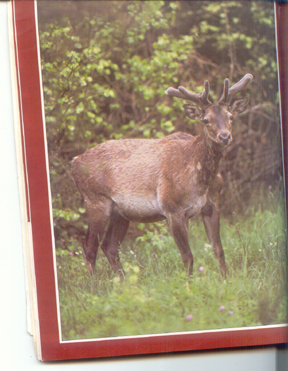
( Hangul stag by Joanna van Gruisen taken from the Sanctuary publication)
More photographs of nature/wildlife in Kashmir 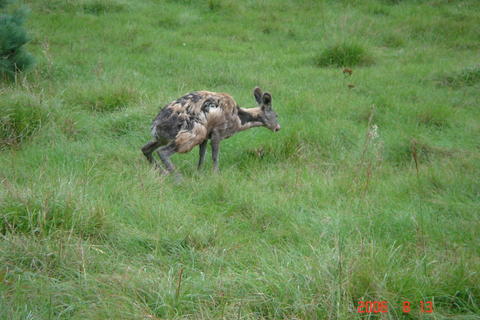 Female musk deer in a deer sanctuary on the way to
Aaaroo Female musk deer in a deer sanctuary on the way to
Aaaroo 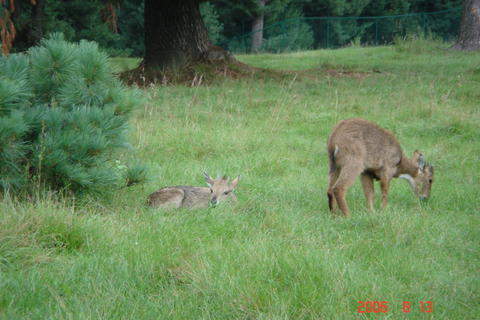 Ghorals in the sanctuary Ghorals in the sanctuary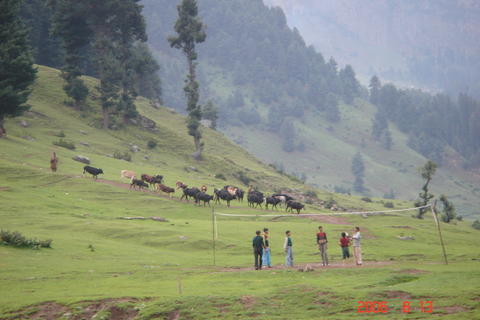 Gulmarg slopes
Gulmarg slopes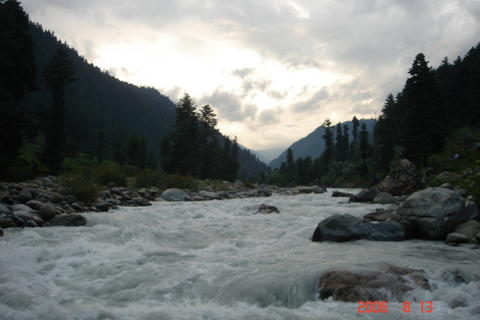 Lidder River which runs through Kashmir Lidder River which runs through Kashmir
Note: Our trip was organized by Discovery Journeys, Gurgaon. For customised and personalised trips/tours contact them at
http://www.indianwildlifeclub.com/EcoTourism/Discovery-Journeys.aspx
|
|
|
|
Posted by
Susan Sharma
on
February 07, 2007

HIGHLIGHTNING TOURISM’S ROLE IN CLIMATE RESPONSE
"There is now
unequivocal proof from the Intergovernmental Panel on Climate Change
and the Stern report that climate challenge is real and that we must
all play our part in its resolution. Tourism is an important sector
of the global economy and a vital link in human communications,
cultural interface and development. Like other key sectors, we play a
part in the problem and we have to be responsive and responsible as
temperatures, sea levels and other climactic conditions evolve. We
will work even more closely with UNEP and other sister agencies like
the International Civil Aviation Organization, as well as the private
sector, in exploring new patterns of consumption and conservation, as
well as fast track strategies for adaptation", Mr. Frangialli, UNWTO Secretary-General, said.
There will be two overriding considerations for UNWTO, the Secretary-
General added. "First, promoting responsible growth of tourism to
advance global trade, as well as strengthening the links between
people and cultures which foster mutual understanding. This will mean
innovative adaptation across the sector using all the tools and
technologies as they become available. Second, ensuring that tourism
remains a key tool to achieve the Millennium Development Goals and
helping poor nations lift themselves out of the poverty trap.
Tourism
represents 40% of services exports and the world’s poorest countries
have comparative advantage in this area which must be encouraged as a
part of responsible climate change strategies."
UNWTO and UNEP have agreed to strengthen their cooperation in a
number of ways – most immediately, UNWTO will join the billion tree
planting campaign of UNEP and the environment agency will strengthen
its support for UNWTO’s Global Code of Ethics for Tourism to upbeat
the sustainability and climate response components. The organizations
will collaborate on the Tourism Climate Change Summits.
United Nations Environment Programme (UNEP) - BillionTree Campaign
http://www.unep.org/billiontreecampaign/
|
Posted by
Mohamed Sheik Ravuthar
on
February 07, 2007

|
POINT CALIMERE
M MOHAMED SHEIK RAVUTHAR
Forests and wildlife of Nagapattinam district
Other animals of the sanctuary include the jackal, spotted deer, jungle cat,
feral horses, black napped hare, etc. including a variety of reptiles.
From October to January nearly 90 species of migratory water birds
visit the sanctuary and its surroundings. They include Flamingoes, Painted storks,
Pelicans, Spoonbills, ducks, teals and a variety of shore birds. The best time to visit
the sanctuary for bird watching is November-December. The sanctuary is open to
visitors throughout the year.
A Forest Rest House at Kodiakkarai is available for visitors to the sanctuary.
Visitors may contact Wildlife Warden at 04365- 253092 or
Ranger, Kodiakkarai at 04369-272424

Blackbuck- the most important herbivore

Olive Ridley turtles nests in the sanctuary beach from Jan-March


On 14th November, 2000 a 35 ft long Bryde’s whale was rescued
from mud about 10 km west of Kodiakkarai. The rescue operation was
carried out with the active support of district administration. Pic: Top: A full grown Bryde’s whale. Bottom: Diagram showing padding of whale for towing during rescue.The sanctuary is now declared
as a Ramsar site
Sanctuary vegetation
Tropical dry-evergreen forest covers nearly 15 sq.kms of Pt. Calimere
Wildlife sanctuary. The forests are mostly of the nature of scrubland that
stands on low sand dunes located on the western half of the sanctuary.
Manilkara hexandra, locally called Palai is the most important evergreen
species of the sanctuary forest. In the sanctuary grasslands the dominant
graminoid is Aeluropus lagopoides followed by Sporobulu tremulus and
Cressa cretica. The forest is home to 154 species of medicinal plants
like Mucuna pruriens, Solanum trilobatum, Tinospora cordifolia Randia
dumatorum and Cissus quadrangularis
|
| |
|
Posted by
Susan Sharma
on
February 06, 2007

IPCC Report on Global Warming
The most authoritative scientific report on climate change says with
90% certainty that the burning of fossil fuels and other human
activities are driving climate change.
The report, from the UN’s Intergovernmental Panel on Climate Change
(IPCC) says the rise in global temperatures could be as high as 6.4°C
by 2100. The report also predicts sea level rises and increases in hurricanes.
The new IPCC report is the work of 3750 climate experts, who have
spent six years reviewing all the available climate research. It was
released in Paris, France, on Friday.
Considering the human role in causing climate change, the IPCC report is damning: "The understanding of [human] influences
on climate has improved since the [2001] report, leading to a very high confidence that human activities" are responsible for most of the warming seen since 1950, says the report’s summary for policymakers. “Very high confidence” is described as “at least
a 9 out of 10 chance of being correct”.
Before the industrial revolution, human greenhouse gas emissions were small, and the atmospheric concentration of carbon dioxide – the main greenhouse gas – was about 280 parts per million (ppm).
Thanks largely to the burning of fossil fuels and changes in land use, such as agricultural exploitation and deforestation, the atmospheric
concentration of carbon dioxide reached 379 ppm in 2005
Read the full story here:
http://environment.newscientist.com/article/dn11088-blame-for-global-warming-placed-firmly-on-humankind.htm
|
Posted by
Susan Sharma
on
February 04, 2007
A picture story sent in by a friend was so moving I thought we must have a blog topic exclusively for "anthromorphism". Anthropomorphism, also called personification, is the attribution of human characteristics and qualities to nonhuman beings.
Scientists at one time used to look down upon such stories-as figments of human imagination. But as human beings are observing and flming more deeply into the private lives of animals, realisation is slowly dawning that we were probably too egoistic to acknowledge
that animals have intelligence and emotions!
Read the story at this link
http://www.juliusbergh.com/cocky
|
Posted by
Jayanth Sharma
on
February 01, 2007
I travelled to the lesser known Daroji Bear Sanctuary a few days back. with atleast 22 sightings of the Sloth bears, the trip was very succesful.
View Trip report
|